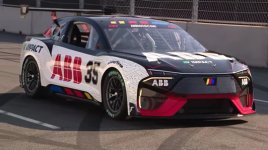As of 2024, NASCAR hasn't fully transitioned to electric cars, but there have been significant developments towards incorporating electric vehicles (EVs) into the sport. Here's an overview of the current state and some speculative information based on what an electric NASCAR vehicle could look like.
NASCAR's Electric Future:
Hybrid Transition: NASCAR has been planning to introduce hybrid powertrains, likely by 2024 or 2025. This move is seen as a stepping stone towards full electrification, allowing teams and manufacturers to adapt to new technologies gradually.
Electric Series: There has been discussion about the potential for a dedicated NASCAR electric series, which would run alongside the traditional gasoline-powered series. However, as of now, no official timeline has been set for a full-electric NASCAR series.

Speculative Electric NASCAR Car Specifications:
Range:
Expected Range: If NASCAR were to adopt fully electric vehicles, the race cars would need to have enough range to complete a race without frequent pit stops for charging. This could mean a range of around 150-200 miles on a single charge, depending on the race length and energy management strategies.
Speed:
Top Speed: Electric NASCAR vehicles would likely have top speeds comparable to current internal combustion engine (ICE) cars, which can exceed 200 mph. Electric motors provide instant torque, which could result in even quicker acceleration than current NASCAR vehicles.
Acceleration: With the instant torque provided by electric motors, an electric NASCAR car could potentially achieve 0-60 mph in under 3 seconds, making it faster off the line than current cars.
Battery and Charging:
Battery Capacity: A high-capacity battery, likely around 80-100 kWh or more, would be necessary to support the power demands and range needed for a NASCAR race.
Charging Time: Rapid battery swaps or ultra-fast charging technologies (similar to those being developed for Formula E) would be crucial to minimize downtime during races.
Weight and Handling:
Weight: Electric vehicles tend to be heavier due to their batteries. This could impact the handling and require adjustments to the car's design and aerodynamics to maintain the high-speed cornering capability NASCAR is known for.
Balance: Engineers would need to carefully manage weight distribution to ensure that electric NASCAR vehicles maintain or even improve on the handling characteristics of current cars.
Challenges and Considerations:
Heat Management: Electric motors and batteries generate significant heat, which would need to be effectively managed during long races.
Sound: One of the key elements of NASCAR is the roar of the engines. Electric cars are much quieter, which might change the fan experience. However, there could be ways to amplify or simulate engine sounds for the crowd.
Conclusion:
The transition to fully electric NASCAR cars would represent a significant shift in the sport, requiring new technologies and strategies. While NASCAR hasn’t fully embraced electric vehicles yet, the ongoing development of hybrid systems and discussions around EVs indicate that the sport is heading in that direction. An electric NASCAR car could be incredibly fast and powerful, but the range and battery management would be critical to its success in the demanding environment of stock car racing.
Youtube
NASCAR's Electric Future:
Hybrid Transition: NASCAR has been planning to introduce hybrid powertrains, likely by 2024 or 2025. This move is seen as a stepping stone towards full electrification, allowing teams and manufacturers to adapt to new technologies gradually.
Electric Series: There has been discussion about the potential for a dedicated NASCAR electric series, which would run alongside the traditional gasoline-powered series. However, as of now, no official timeline has been set for a full-electric NASCAR series.

Speculative Electric NASCAR Car Specifications:
Range:
Expected Range: If NASCAR were to adopt fully electric vehicles, the race cars would need to have enough range to complete a race without frequent pit stops for charging. This could mean a range of around 150-200 miles on a single charge, depending on the race length and energy management strategies.
Speed:
Top Speed: Electric NASCAR vehicles would likely have top speeds comparable to current internal combustion engine (ICE) cars, which can exceed 200 mph. Electric motors provide instant torque, which could result in even quicker acceleration than current NASCAR vehicles.
Acceleration: With the instant torque provided by electric motors, an electric NASCAR car could potentially achieve 0-60 mph in under 3 seconds, making it faster off the line than current cars.
Battery and Charging:
Battery Capacity: A high-capacity battery, likely around 80-100 kWh or more, would be necessary to support the power demands and range needed for a NASCAR race.
Charging Time: Rapid battery swaps or ultra-fast charging technologies (similar to those being developed for Formula E) would be crucial to minimize downtime during races.
Weight and Handling:
Weight: Electric vehicles tend to be heavier due to their batteries. This could impact the handling and require adjustments to the car's design and aerodynamics to maintain the high-speed cornering capability NASCAR is known for.
Balance: Engineers would need to carefully manage weight distribution to ensure that electric NASCAR vehicles maintain or even improve on the handling characteristics of current cars.
Challenges and Considerations:
Heat Management: Electric motors and batteries generate significant heat, which would need to be effectively managed during long races.
Sound: One of the key elements of NASCAR is the roar of the engines. Electric cars are much quieter, which might change the fan experience. However, there could be ways to amplify or simulate engine sounds for the crowd.
Conclusion:
The transition to fully electric NASCAR cars would represent a significant shift in the sport, requiring new technologies and strategies. While NASCAR hasn’t fully embraced electric vehicles yet, the ongoing development of hybrid systems and discussions around EVs indicate that the sport is heading in that direction. An electric NASCAR car could be incredibly fast and powerful, but the range and battery management would be critical to its success in the demanding environment of stock car racing.
Youtube
